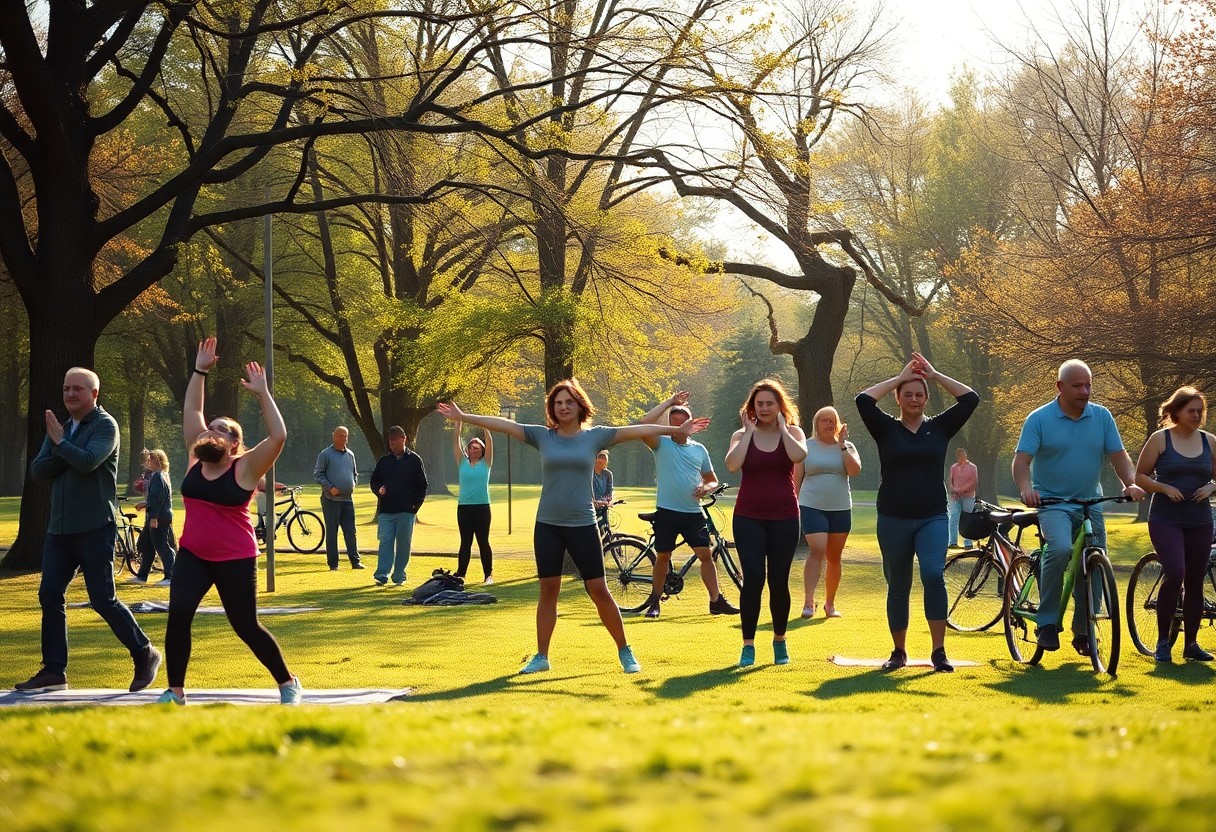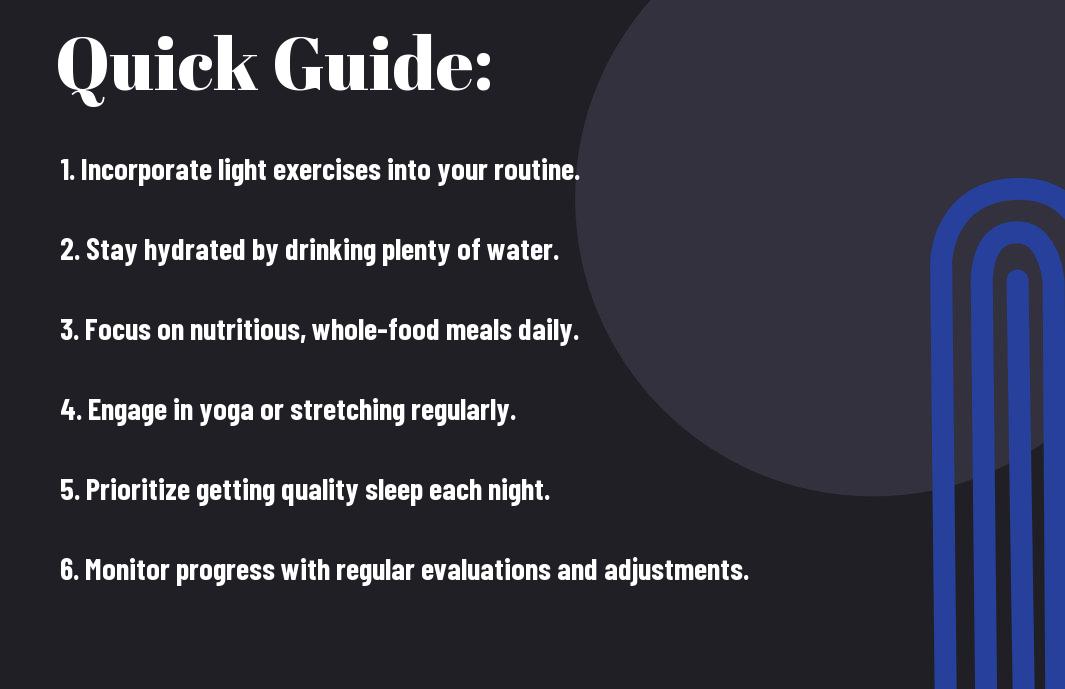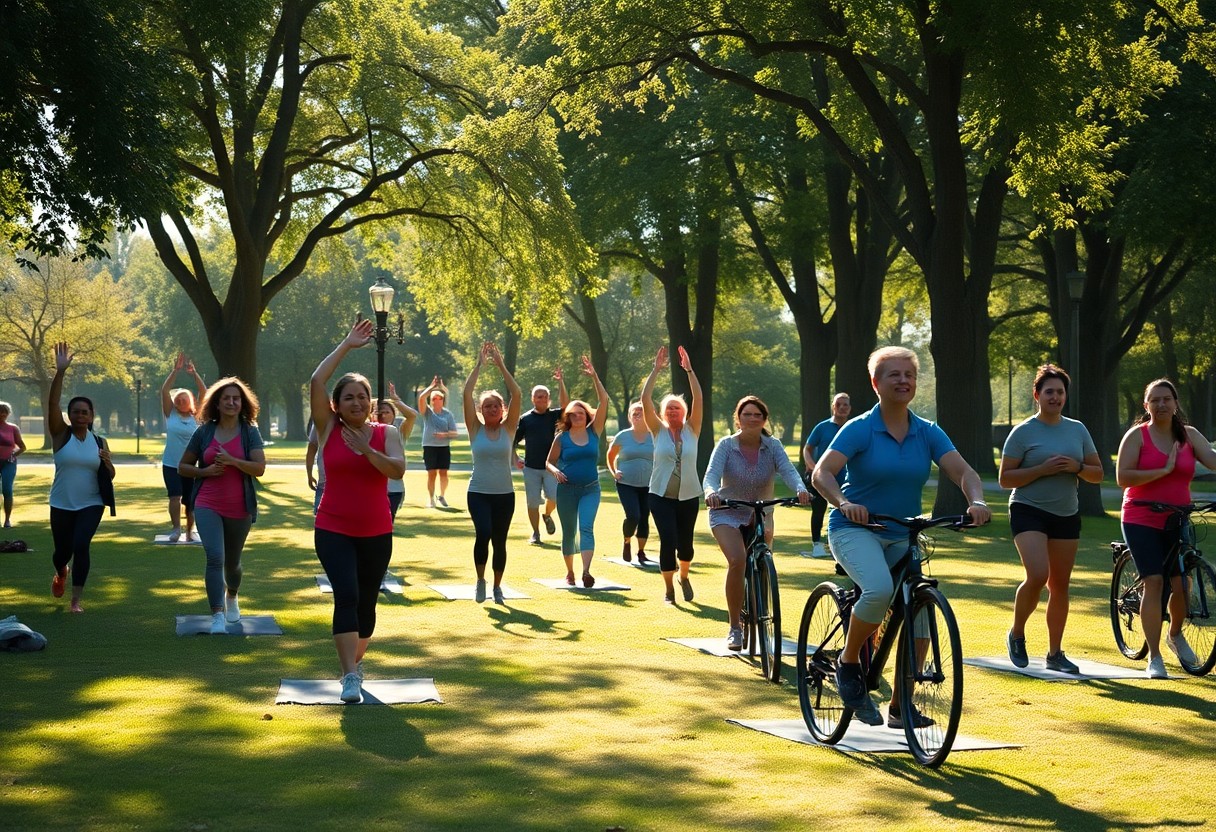Most people overlook the importance of active recovery in their weight loss journey. Incorporating rest activities that promote healing and mobility is crucial for optimizing your workouts and sustaining long-term fat loss. In this guide, you will discover effective active recovery techniques, their benefits, and how to seamlessly integrate them into your routine. By prioritizing these restorative practices, you can enhance your performance, reduce the risk of injury, and ultimately achieve your weight loss goals more effectively.

Key Takeaways:
- Active Recovery: Incorporates low-intensity exercises that promote healing and fitness without causing additional strain on the body.
- Weight Loss Support: Helps burn calories while improving muscle recovery, crucial for maintaining a healthy weight during a fitness regimen.
- Variety of Activities: Can include walking, yoga, swimming, or cycling at a comfortable pace, ensuring a holistic approach to fitness.
- Enhanced Blood Circulation: Facilitates better nutrient and oxygen delivery to muscles, aiding recovery and promoting fat loss.
- Stress Reduction: Engaging in low-intensity activities can lower stress levels, which is important for effective weight loss and overall well-being.
- Improved Flexibility: Regular active recovery contributes to greater flexibility and range of motion, enhancing performance in more intense workouts.
- Consistent Routine: Incorporating active recovery into a regular schedule helps sustain motivation and adherence to fitness goals for lasting results.

Understanding Active Recovery
For effective weight loss, it’s vital to integrate active recovery into your fitness regimen. Active recovery involves low-intensity activities that help your body recover while still keeping you moving. This approach not only aids in muscle recovery but also enhances overall well-being, ensuring you remain committed to your weight loss journey.
Types of Active Recovery
For optimal results, you should explore various types of active recovery activities, including:
- Walking or light jogging
- Swimming or cycling
- Yoga or stretching exercises
- Recreational sports
- Foam rolling or mobility work
Knowing the types of active recovery available helps you choose what suits your lifestyle and goals best.
| Type of Activity | Description |
| Walking | Low-intensity, easy to incorporate into your daily life. |
| Yoga | Focuses on stretching, mobility, and relaxation. |
| Light cycling | A gentle way to keep the legs moving without strain. |
| Swimming | Low-impact cardio that engages various muscle groups. |
| Foam rolling | Helps relieve muscle tightness and enhance recovery. |
Benefits for Weight Loss
Weight loss is often most effective when you include active recovery in your workout plan. This approach helps you maintain your fitness routine without overexerting yourself, making it easier to adhere to your long-term goals.
Active recovery not only aids in muscle repair and reduces soreness but also keeps your metabolism engaged, promoting fat loss. Engaging in these restorative practices allows you to enjoy the process while minimizing the risk of injury or burnout. By incorporating active recovery into your program, you’ll find that your body can recover more efficiently, enabling you to stay committed to your fitness objectives.

Effective Active Recovery Tips
Now, implementing effective active recovery techniques can significantly enhance your weight loss journey. Here are some tips to optimize your recovery:
- Engage in low-intensity workouts like walking or yoga.
- Incorporate stretching to improve flexibility.
- Stay hydrated to facilitate recovery.
- Listen to your body and avoid overexertion.
After following these tips, your body will feel better prepared for your next workout session.
Incorporating Lifestyle Changes
Incorporating lifestyle changes into your daily routine can enhance your active recovery process. Focus on getting adequate sleep, maintaining a balanced diet, and staying mentally engaged. Taking leisurely activities like hiking or cycling can keep you active without straining your body. Small changes like these can lead to long-term benefits and support your weight loss efforts.
Best Practices for Consistency
To maintain consistency during your active recovery routine, establish a schedule that fits seamlessly into your daily life. Set realistic goals and allow flexibility for unforeseen circumstances. This approach prevents burnout while keeping you committed to your recovery plan.
Another effective tactic is to track your progress. Use a journal or app to log your activities and recovery sessions. Being aware of your accomplishments can keep you motivated. Moreover, surrounding yourself with supportive peers can encourage you to stick to your active recovery practices consistently.
Step-by-Step Active Recovery Routine
All successful active recovery routines follow a structured approach to ensure effectiveness. Below is a simple framework to guide you through your active recovery journey:
| Step | Activity |
|---|---|
| 1 | Light Stretching |
| 2 | Walking or Light Jogging |
| 3 | Yoga or Pilates |
| 4 | Foam Rolling |
| 5 | Hydration and Nutrition |
Designing Your Routine
Step by step, design your active recovery routine to fit your lifestyle and fitness goals. Begin by dedicating at least one day a week to low-impact activities that promote blood flow without straining your muscles. Incorporate a mix of stretching, gentle movements, and hydration to ensure comprehensive recovery.
Monitoring Your Progress
Designing a system for tracking your routine can help you stay accountable. Keep a journal or use a fitness app to log your activities, the duration of each session, and how you feel afterward. This will help you identify patterns in how your body responds to different activities.
With consistent monitoring, you’ll gain insights into what works best for your recovery needs. Adjust your routine based on your logged experiences, allowing you to optimize your active recovery strategy over time. This process not only enhances your effectiveness but also keeps you motivated on your weight loss journey.

Factors Affecting Active Recovery
Once again, several factors can influence the effectiveness of your active recovery sessions. Understanding these can help you tailor your approach to meet your weight loss goals. Key considerations include:
- Individual fitness levels
- Type of activity performed
- Duration and consistency of recovery sessions
- Nutritional intake
Assume that you adjust your recovery strategies based on these factors for optimal results. You can also explore 3 Active Recovery Workouts for Your Next Rest Day for additional insights.
Individual Differences
Individual variations in fitness levels, age, and overall health shape how you respond to active recovery. What works for one person may not be as effective for you, so paying attention to your body’s signals is imperative. Listen to how your body feels post-activity to make necessary adjustments.
Frequency and Intensity
One of the most significant factors affecting active recovery is the frequency and intensity of your workouts. You need to balance your routine to enhance recovery while still promoting weight loss. Too much intensity can hinder recovery, while too little may not provide the desired benefits.
For instance, engaging in light aerobic activities, such as walking or cycling, a few times per week can allow your body to recover without overtaxing your muscles. It’s imperative to find a frequency that keeps you active without causing fatigue. Keeping this in mind can optimize your active recovery sessions and support your overall fitness journey.
Pros and Cons of Active Recovery
Not all exercise methods have the same benefits, and active recovery is no exception. Understanding the pros and cons can help you decide if it fits your weight loss journey. Below is a breakdown of the advantages and disadvantages:
| Pros | Cons |
|---|---|
| Enhances recovery | May not burn many calories |
| Improves flexibility | Risk of overtraining |
| Reduces muscle soreness | Time-consuming for some |
| Encourages consistent activity | Requires supervision for beginners |
| Boosts mental well-being | Not sufficient for intensive weight loss |
Explore more about Active Recovery: How It Works and Exercise Ideas to see how it might work for you.
Advantages for Weight Loss
On your weight loss journey, active recovery can play a supportive role. It allows you to stay active while promoting muscle repair and recovery. Incorporating light exercises such as walking or yoga can help you maintain a calorie deficit without the fatigue associated with high-intensity workouts. This balanced approach helps you sustain your motivation and engage in your fitness routine consistently.
Potential Drawbacks
You might find that there are some limitations to active recovery, especially regarding its effectiveness in calorie burning. Engaging in low-intensity activities might not provide the same caloric deficit as a more vigorous exercise routine. Thus, relying solely on active recovery may slow your weight loss progress.
Advantages might include factors like improved flexibility and reduced muscle soreness, but don’t overlook that the caloric burn is lower compared to high-intensity sessions. Balancing your routine with both active recovery and more intense workouts could provide a comprehensive approach to your fitness goals and weight loss journey.
Summing up
With this in mind, adopting an active recovery approach can greatly enhance your weight loss journey. By incorporating low-intensity activities like walking, yoga, or swimming into your routine, you not only facilitate muscle recovery but also maintain caloric burn, making it easier to achieve your goals. Listening to your body and balancing rest with gentle movement can help you stay motivated and engaged in your fitness regimen. Ultimately, an active recovery strategy supports sustainable weight loss and overall well-being, empowering you to reach your targets more effectively.
FAQ
Q: What is an Active Recovery Guide for Weight Loss?
A: An Active Recovery Guide for Weight Loss is a structured plan that combines exercise, nutrition, and rest to promote weight loss while allowing the body to recover. It emphasizes low-intensity activities that support muscle repair and overall well-being, making it easier to stay on track with your weight loss goals.
Q: How does active recovery benefit weight loss?
A: Active recovery helps maintain a calorie deficit without overstressing the body. It promotes blood flow to the muscles, aids in clearing out metabolic waste, and supports muscle regeneration. Integrating active recovery into your routine can enhance metabolic rate and improve overall fitness levels, which collectively contribute to weight loss.
Q: What types of activities are considered active recovery?
A: Activities suitable for active recovery include light jogging, walking, cycling at a leisurely pace, yoga, and swimming. These activities should be low-impact and should not strain the body, allowing for recovery while still keeping you physically active.
Q: How often should I include active recovery sessions in my routine?
A: The frequency of active recovery sessions can vary based on individual fitness levels and exercise intensity. Generally, incorporating these sessions 1-3 times a week can be beneficial, particularly after high-intensity workouts. Listening to your body and adjusting based on how you feel is always recommended.
Q: What role does nutrition play in an Active Recovery Guide for Weight Loss?
A: Nutrition is vital in an Active Recovery Guide, as it fuels the body during recovery, replenishes energy stores, and helps repair muscle tissue. A balanced diet rich in whole foods, lean proteins, healthy fats, and complex carbohydrates can enhance recovery and support weight loss efforts.
Q: Can I lose weight solely through active recovery activities?
A: While active recovery activities contribute positively to weight loss, they are most effective when combined with a balanced diet and other forms of exercise. Relying solely on low-intensity activities may not create a sufficient calorie deficit to achieve significant weight loss; therefore, a comprehensive approach is recommended.
Q: How long should an active recovery session last?
A: An active recovery session can last anywhere from 20 to 60 minutes, depending on personal fitness levels and goals. The key is to maintain a pace that feels comfortable and allows for relaxation while still being active. Finding a duration that suits your lifestyle will enhance your adherence to the plan.




